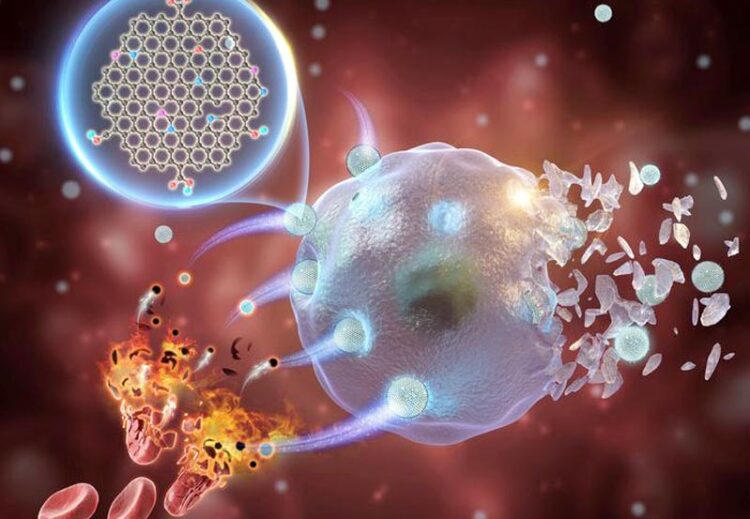Metal-free graphene quantum dots show promise for highly efficient tumor therapy

Schematic illustration showing the role of GQDs, derived from erythrocyte membranes, as peroxidase--mimic enzyme for tumor catalytic therapy.
Credit: LIU Hongji
A research group led by Prof. WANG Hui from the Hefei Institutes of Physical Science of the Chinese Academy of Sciences has introduced a metal-free nanozyme based on graphene quantum dots (GQDs) for highly efficient tumor chemodynamic therapy (CDT).
The study was published in Matter.
GQDs represent a promising and cost-effective means of addressing the toxicity concerns associated with metal-based nanozymes in tumor CDT. However, the limited catalytic activity of GQDs has posed significant challenges for their clinical application, particularly under challenging catalytic conditions.
“The obtained GQDs, which are made from red blood cell membranes, are highly effective in treating tumors with few side effects,” said LIU Hongji, a member of the research team. “One of the advantages is that they are metal-free. In addition, they function as excellent peroxidase-like biocatalysts.”
To enhance the catalytic performance of the GQD-based nanocatalytic adjuvant, the researchers rationally designed GQDs using a diatomic doping strategy. The synergistic electron effect of introducing nitrogen and phosphorus into GQDs can generate highly localized states near the Fermi level, thus enabling efficient enzymatic activity compared to single heteroatom doping.
The obtained GQDs, derived from erythrocyte membranes, have been shown to possess impressive peroxidase-mimicking activity. As a result, the GQDs are highly effective at inducing apoptosis and ferroptosis of cancer cells in vitro. They also selectively target tumors, with a tumor inhibition rate as high as 77.71% for intravenous injection and 93.22% for intratumoral injection, with no off-target side effects.
This drug-free, target-specific, and biologically benign nanozyme has great potential as a potent biocatalyst for use in safe cancer treatment.
Journal: Matter
DOI: 10.1016/j.matt.2023.12.005
Article Title: Graphene quantum dots as metal-free nanozymes for chemodynamic therapy of cancer
Article Publication Date: 10-Jan-2024
Media Contact
Weiwei Zhao
Hefei Institutes of Physical Science, Chinese Academy of Sciences
annyzhao@ipp.ac.cn
Office: 86-551-655-91206
Original Source
https://english.hf.cas.cn/nr/bth/202401/t20240110_655030.html
Media Contact
All latest news from the category: Health and Medicine
This subject area encompasses research and studies in the field of human medicine.
Among the wide-ranging list of topics covered here are anesthesiology, anatomy, surgery, human genetics, hygiene and environmental medicine, internal medicine, neurology, pharmacology, physiology, urology and dental medicine.
Newest articles

First-of-its-kind study uses remote sensing to monitor plastic debris in rivers and lakes
Remote sensing creates a cost-effective solution to monitoring plastic pollution. A first-of-its-kind study from researchers at the University of Minnesota Twin Cities shows how remote sensing can help monitor and…

Laser-based artificial neuron mimics nerve cell functions at lightning speed
With a processing speed a billion times faster than nature, chip-based laser neuron could help advance AI tasks such as pattern recognition and sequence prediction. Researchers have developed a laser-based…

Optimising the processing of plastic waste
Just one look in the yellow bin reveals a colourful jumble of different types of plastic. However, the purer and more uniform plastic waste is, the easier it is to…



